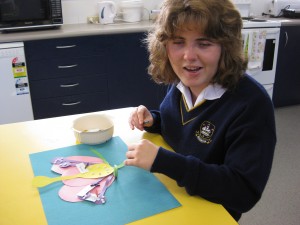
Figure 1 Wikitoria in class
Wikitoria is 10 years old and she attends a large primary school in her local area. She is a 0.1 ORS student on the BLENNZ roll. In figure 1 Wikitoria is in class.
Wikitoria is working with her BLENNZ Resource Teacher Vision (RTV), Robyn Black to her improve literacy skills.
Specific areas of focus during their weekly sessions include comprehension and following instructions. As well as learning to follow written instructions Wikitoria is also learning to problem solve and interpret information. Continue Reading →

Figure 1 Lizzie using BrailleNote to create labels
Lizzie is 15 years old and is studying at James Cook Satellite Class. James Cook Satellite Class consists of 8 visually impaired students, BLENNZ classroom teachers Marie Price and Ravjeet Kaur and two teacher aides.
Here Ravjeet Kaur shares how Lizzie is learning how to access the tactile diagrams. In figure 1 shows Lizzie labelling the parts of the flower using tactile diagram and BrailleNote.
Tactile skills to access information

Figure 2 Lizzie labelling the flower
Lizzie is learning the skills required for accessing information about the arrangement of floral parts by using the tactile diagrams, tactile poster, braille text book.
In figure 2 Lizzie is labelling the parts of the flower.
Prerequisite skills
Lizzie is a fluent braille reader and writer. She has gained the knowledge about the parts of the flower and their shape and function.
Figure 3 shows Lizzie matching the labels with the floral structures.

Figure 3 matching the labels with the floral structures
Possible next steps
- Explore the flower and find out where each part of the flower is located – for example, where can you find the petals, sepals etc. on a flower.
- Describe the difference between the whole object and the cross-section of an object – for example, by using a whole tomato, flower and cross section of a tomato, flower etc.
- Learn the arrangement of the flower by using tactile diagrams.
- Describe the arrangement of the flower by producing a tactile poster.
Teaching methods and strategies
- Four Science lessons per week.
- Use of braille text books, tactile diagrams, tactile posters.
- Day trip including the Science session at the botanical garden.
- Going out in the garden and feeling (touch, smell, colour) the flowers and finding out where on the plant the flowers are located.
- Breaking down the learning steps to students level.
- Making tactile posters.
- Matching card activities.
- Group discussion.
- 1-to-1 support.
Learning adaptations
- Extra time allocated for Lizzie to develop skills for tactile diagram identification and sequencing.
- Integrating the fragmented pieces of information one at a time into a meaningful and coherent whole.
- Access to both pictures and text (braille text books, tactile diagrams, concrete object).
- Lots of verbal prompting was given for Lizzie to recall the information covered in the prior lessons.
Assessment
- Evidence of progression of learning taken from submission of home work, active contributions during class activities, answering the questions
- Teacher classroom observations.
- Production of tactile posters with support.
Useful links
More information
Email us at BLENNZ Online for more information about this subject.
We will link you up with either the author of this post or another BLENNZ colleague with whom you can continue your conversation.




